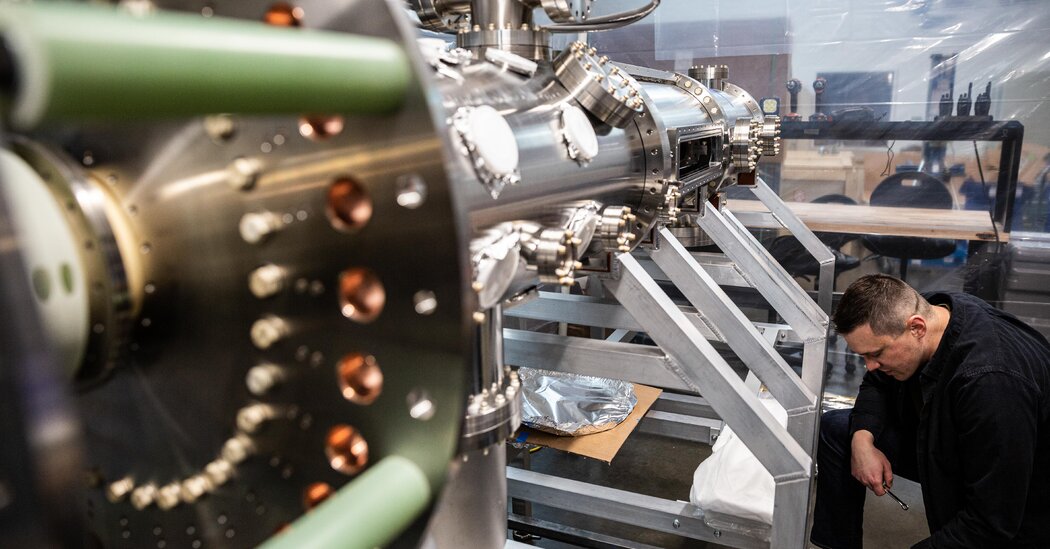
Zap Energy, a fusion energy start-up working on a low-cost path to producing electricity commercially, said last week that it had taken an important step toward testing a system its researchers believe will eventually produce more electricity than it consumes.
That point is seen as a milestone in solving the world’s energy challenge while it moves away from fossil fuels. An emerging global industry composed of almost three dozen start-ups and heavily funded government development projects is pursuing a variety of concepts. Zap Energy, based in Seattle, stands out because its approach — if it works — would be simpler and cheaper than what other companies are doing.
Today’s nuclear power plants are based on fission, which captures the energy released by splitting atoms. In addition to intense heat, byproducts of the process include waste that remains radioactive for centuries. Nuclear fusion, on the other hand, replicates the process that takes place inside the sun, where gravitational forces fuse hydrogen atoms into helium.
For more than a half-century physicists have pursued the vision of commercial power plants based on a controlled fusion reaction, essentially bottling the power of the sun. Such a power plant would produce many times more electricity than it consumed and without the radioactive byproducts. But none of the research projects have come anywhere close to the goal. Still, as fear of climate change mounts, there is growing interest in the technology.
“We think it’s vital that fusion become part of our energy mix,” said Benj Conway, Zap Energy’s president.
While many competing efforts use powerful magnets or bursts of laser light to compress a plasma in order to initiate a fusion reaction, Zap is pursuing an approach pioneered by physicists at the University of Washington and Lawrence Livermore National Laboratory.
It relies on a shaped plasma gas — an energized cloud of particles that is often described as a fourth state of matter — that is compressed by a magnetic field generated by an electrical current as it flows through a two-meter vacuum tube. The technique is known as “sheared flow Z-pinch.”
Zap Energy’s “pinch” approach is not new. It may have been observed in the effects of lightning strikes as early as the 18th century and has been proposed as a path to fusion energy since the 1930s. While pinches occur naturally in lightning strikes and solar flares, the challenge for engineers is to stabilize the electrical and magnetic forces long enough in pulses — measured in a millionth of a second — to produce radiation to heat a surrounding curtain of molten metal.
Brian Nelson, a retired University of Washington nuclear engineer and Zap Energy’s chief technology officer, said the company had successfully injected plasma into a new and more powerful experimental reactor core. It is now completing a power supply that is designed to provide enough energy to allow the company to prove that producing more energy than it consumes is possible.
If their system proves workable, the Zap researchers say, it will be orders of magnitude less expensive than competing systems based on magnet and laser confinement. It is expected to cost roughly the same as traditional nuclear power.
Researchers attempting the Z-pinch design have found it impossible to stabilize the plasma and abandoned the idea in favor of the magnet approach, known as a Tokamak reactor.
Advances in stabilizing the magnetic field that is generated by the flowing plasma made by physicists at the University of Washington led the group to establish Zap Energy in 2017. The company has raised more than $200 million, including a series of investments from Chevron.
Recent technical advances in fusion fuels and in advanced magnets have led to a sharp increase in private investment, according to the Fusion Industry Association. There are 35 fusion companies globally, and private funding has risen above $4 billion, including from well-known technology investors like Sam Altman, Jeff Bezos, John Doerr, Bill Gates and Chris Sacca. Mr. Gates and Mr. Sacca invested in Zap’s most recent funding round.
But there are still vocal skeptics who argue that progress in fusion energy research is largely a mirage and that recent investments are unlikely to translate into commercial fusion systems anytime soon.
Last fall, Daniel Jassby, a retired plasma physicist at Princeton University, wrote in an American Physical Society newsletter that the United States was in the middle of another round of “fusion energy fever,” which has come and gone each decade since the 1950s. He argued that claims made by start-up companies that they were on a path to successfully build systems that produced more energy than they consumed had no basis in reality.
“That these claims are widely believed is due solely to the effective propaganda of promoters and laboratory spokespersons,” he wrote.
The Zap Energy physicists and executives said in interviews last week that they believed they were within a year of proving that their approach was capable of reaching the long-sought-after energy break-even point.
If they do, they will have succeeded where an array of research efforts — going back to the middle of the last century — have failed.
The Zap Energy physicists said they had made the case for the “scaling” power of their approach to produce a steep increase in neutrons in a series of peer-reviewed technical papers that documented computer-generated simulations they would soon begin to test.
A power plant version of the system would shroud the reactor core in moving molten metal to capture bursts of neutrons resulting in intense heat, which would be converted to steam that would in turn generate electricity.
Each reactor core will produce about 50 megawatts of electricity, roughly enough to power at least 8,000 homes, said Uri Shumlak, a physicist and University of Washington professor who is a co-founder of Zap Energy.
Their technical challenge now is to confirm what they have simulated by computer, he said. That will include ensuring that the Z-pinch fusion section of the plasma remains stable and that they are able to design an electrode that can survive in the intense fusion environment of the reactor.
Mr. Conway said he hoped Zap would be able to prove their concept quickly, unlike the big, high-cost development efforts of the past, which have been like “building a billion-dollar iPhone prototype every 10 years.”




